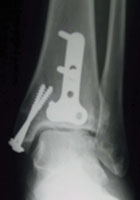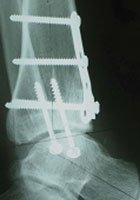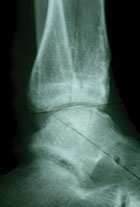Promising preliminary results seen with ankle distraction for post-traumatic OA
Of the 40 patients in the study, five required an arthrodesis after undergoing distraction.
Click Here to Manage Email Alerts
Emerging research from the University of Iowa indicates that ankle distraction may lead to improved pain relief and function in young and active patients with endstage post-traumatic ankle osteoarthritis.
“At the present time, the standard option for these types of patients is usually arthrodesis of the ankle or, in the older patients, arthroplasty,” Annunziato Amendola, MD, told Orthopedics Today. “Both of those options have downfalls. If you could maintain the ankle joint, obviously, it would be advantageous. Ankle distraction is a technique designed to restore the ankle joint space and reduce the patient’s pain so that he or she does not need one of those other procedures.”
Prospective study
In an ongoing prospective study, Amendola and colleagues are evaluating 40 patients with Stage IV post-traumatic ankle osteoarthritis (OA) who were randomized to receive either 3 months of ankle distraction alone or 3 months of ankle distraction with intermittent motion. Both groups had 5 to 7 mm of distraction using the Ilizarov fixator (Smith & Nephew).
|
|
|
|
Shown here, a 49-year-old male with severe end-stage post-traumatic osteoarthritis of the ankle. Images: Amendola A |
|
For the intermittent motion group, the investigators placed hinges on the medial and lateral bars of the distractor which allowed the patients to undergo a range of motion on a regular basis during the 3-month distraction period.
Patients in both study groups had their fixators removed after 3 months and were placed in a nonweight-bearing walking boot and underwent range of motion exercises for 1 month. They then wore a weight-bearing boot and continued range of motion exercises for an additional month before the boot was removed and they could weight-bear without aid.
The study group included 28 men and 12 women. The patients had a mean age of 40.9 years, a mean weight of 197.47 pounds and a mean height of 69 inches.
Early outcomes
The preliminary results indicate ankle distraction as a promising procedure, Amendola said.
“I would say about three-fourths of the patients have benefited from the distraction procedure,” he said. Of the total study group, five patients underwent a subsequent arthrodesis during the 4-year follow-up. A comparison of preoperative and 24-month postoperative average Ankle Osteoarthritis Scale subscale scores also show a 25-point decrease in pain and a 30-point decrease in disability.
|
|
“The most prevalent complication that we had is pin tract infection,” Amendola said. He noted that nearly all of the patients developed a mild, local pin tract infection which was treated with local wound care and antibiotics.
“We had a couple of broken pins which had to be replaced,” he said. “One of the other problems is that when you distract the joint, you also distract the soft tissues. We had three patients with some neuropraxia after the whole thing was over.”
Considerations
Amendola said that ankle distraction is generally a new treatment and noted that the amount of distraction used for the study was based on research conducted by investigators from Utrecht University. “A lot of these parameters — about how much should you distract, how long should you distract, should you use motion or no motion — are not fully determined about what is optimal,” he said.
The procedure is not indicated for older patients, those with poor bone stock or malalignment, Amendola said. Surgeons should ensure that patients are educated about the procedure.
|
|
“[It] is quite a commitment for the patient to do this,” he said. “[They] have to undergo the surgery for 3 months and then another 2 to 3 months of rehabilitation, so it has to be the right patient who understands what the surgery entails and what the purpose of the surgery is. It is not going to make their ankle completely normal. The purpose of the surgery is to relieve their pain and get them at a functional level and trying to avoid doing an arthrodesis or fusion in the ankle.”
Amendola noted that many mysteries remain regarding distraction including the potential impact of biologics and why the procedure works.
“We see that the patients are improved and we see that the joint space is widened again, but why does that happen and why does it work?” he asked. “What is the quality of the tissue that is in the joint, and can we improve whatever is happening there with biologic stimulation or intervention?”
A note from the editors:
This is the last of a four-part series on post-traumatic OA research developments. To view the previous installments, log on to ORTHOSuperSite.com and search for the key phrase: post-traumatic OA.
For more information:
- Annunziato Amendola, MD, is director of sports medicine at the University of Iowa; 319-356-4230; e-mail: ned-amendola@uiowa.edu. He can be reached at the University of Iowa Hospitals and Clinics, 200 Hawkins Drive, Iowa City, IA 52242. The research was supported by a National Institutes for Health grant SCOR NIH P 50 AR 048939.




